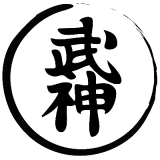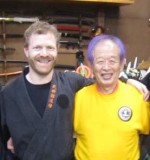Bujinkan Martial Arts
We are very proud to be licensed members of the Bujinkan which is a large and growing international organisation. Our members pay annual membership to the Bujinkan.
We are the only club in Brighton authorised to teach the Bujinkan arts of Ninpo and Budo.

Bujinkan Budo Taijutsu is an amalgamation of 9 very traditional ancient Japanese martial arts dating back over 900 years. Some Ninjutsu schools some Samurai schools, developed to be a very powerful and effective self-defence system, making one of the very few true martial arts, not a sport with rules, regulations and referees. But simple pragmatic techniques, all practised in such a way to prevent injury and danger. Both physical and philosophical methods are practised in a safe manner. Some of the details and specifics regarding the origins of Ninjutsu are clouded in mystery, as that was likely a necessary element of survival for practitioners at the time. Ninjutsu has been sensationalized by Hollywood to depict Ninjas as assassins and spies, which is not what they were.
The ninja have been referred to as “Shadow Warriors”. In Japanese, the are often referred to as Shinobi, which is the shortened version of shinobi-no-mono. Shinobi litterally translates to “to steal away” and “to forbear,” which relates to stealth and invisibility. Mono means “person.”
It is actually true that the ninja are shadow warriors, although not likely for any reason one might first believe. It is not because the ninja hide in the shadows and attack their enemies like prey. Contrary to popular belief, the ninja were not mercenaries. Rather, the ninja is content to live a great life in the shadows of anonymity. Possessing great knowledge and skills, without anyone around them knowing so. The previous Soke of Ninjutsu was Toshitsugu Takamatsu, who when he died was known as the “world’s last combat ninja.” Upon reading his obituary, his neighbours and friends had no idea that he was anything other than a simple tea shop owner. That is the essence of the shadow warrior…
Important!
Be aware that there are organisations in the UK and abroad claiming to teach Ninjutsu and to be affiliated to the Bujinkan based on their senior instructor having trained in the Bujinkan in the past. One in particular uses Bujinkan as part of their title and they use the Bujinkan logo on their training gis. Their views and training methods are not verified or approved of by the Bujinkan and do not necessarily represent Ninjutsu or the Bujinkan. Therefore their training could involve dangerous practices. Please verify your instructors credentials, if unsure you are welcome to email us.
For a list of some international dojos see here and UK dojos here.
Every year, Soke Hatsumi chooses a different theme for the years training. Sometimes its a Bujinkan school or ryu, sometimes a particular choice of weapon, or sometimes a principle. So far, the themes have been:
- 2008 Togakure Ryu Ninpo Taijutsu and Ninja Biken
- 2007 Kukishin Ryu
- 2006 Shinden Fudo Ryu (Principles of Nature)
- 2005 Gyokko-ryu Kosshijutsu Happoubiken (Bo and Tachi)
- 2004 Daishou Juutaijutsu (Roppo-Kuji-no Biken)
- 2003 Juppo Sessho
- 2002 Jutaijutsu (Takagi Yoshin Ryu)
- 2001 Kosshijutsu (Gyokko Ryu)
- 2000 Koppojutsu (Koto Ryu)
- 1999 Kukishinden Ryu
- 1998 Shinden Fudo Ryu
- 1997 Jojutsu
- 1996 Bokken
- 1995 Naginata
- 1994 Yari
- 1993 Rokushakubojutsu
- 1992 Taijutsu Power
- 1991 Sword and Jutte
- 1990 Hanbo
- 1989 Taijutsu and Weapons
- 1988 Taijutsu
The Essence of Ninpo
By Masaaki Hatsumi, 34th Soke of the Togakure Ryu
The Essence of Ninpo By Masaaki Hatsumi, 34th Soke of the Togakure Rye I believe that Ninpo, the highest order of Ninjutsu, should be offered to the world as a guiding influence for all martial artists. The physical and spiritual survival methods eventually immortalized by Japan’s Ninja were in fact one of the sources of Japanese martial arts.
Without complete and total training in all aspects of combative arts, today’s martial artist cannot hope to progress any further than mere proficiency in the limited set of muscular skills that make up his or her training system. Personal enlightenment can only come about through total immersion in a martial tradition as a way of living. By experiencing the confrontation of danger, the transcendence of fear, injury, death, and a working knowledge of individual personal powers and limitations, the practitioner of Ninjutsu can gain strength and invincibility that permit enjoyment of the flowers moving in the wind, appreciation of the love of others, and contentment with the presence of peace in society.
The attainment of this enlightenment is characterized by the development of the jihi no kokoro, or benevolent heart. Stronger than love itself the benevolent heart is capable of encompassing all that constitutes universal justice and all that finds expression in the unfolding of the universal scheme. Born of the insight attained from repeated exposure to the very brink between life and death, Ninpo’s benevolent heart is the key to finding harmony and understanding in the realms of the spiritual and natural material worlds. After so many generations of obscurity in the shadowy recesses of history, the life philosophy of the ninja is now once again emerging, because once again, it is the time in human destiny in which Ninpo is needed. May peace prevail so mankind can continue to grow and evolve into the next great plateau.
Essence of Ninjutsu
By Toshitsugu Takamatsu 33rd Soke, Togakure Ryu
The heart of the martial arts is self-protection. However, the essence of self-protection lies in ninjutsu because ninjutsu also protects one’s spirit. Therefore, without the proper spirit in martial training, one can be led to ruin.
For example, medical technology is dedicated to saving life but the misuse of it can kill people. Eating and drinking are for nourishment. However, overeating harms the body. Politicians are responsible for the governing of countries and the protection of its citizens. When these politicians are greedy, ignorant, and afraid to commit their lives to their endeavors, they only bring about disorder and cause suffering. A religion, when it is sincere and steadfast, can inspire people to protect themselves, make their families thrive, and benefit the society. When it is corrupt, it destroys people and puts the nation in jeopardy.
Therefore, if you are a master of the martial arts and practice ninjutsu, you will gain the most essential secret of all methods. This secret is called shin-shin shin-gan, “the mind and eyes of god”.
This is to know tendo, “the way of heaven”. The truth of heaven excludes all evil spirits and is absolutely correct. People must have faith. This is the only justice which exists in heaven and in people.
Wood, fire, soil, metal, water and spring, summer, fall, winter cannot exist without the earth. The five elemental manifestations and the four seasons balance the earth in the same manner as heaven is balanced by truth.
If a person is honest, virtuous and faithful, he is walking on “the path of heaven”. When he goes with the path of heaven, he is following the will of heaven. This is the mind and eyes of god. Therefore, a ninja has to be a sensible and righteous person. Ninjutsu methods of perseverance can also be understood as methods of perception. A ninja is always calm and never surprised by any situation.
This is the Togakure Ryu martial way.
Toshitsugu Takamatsu
Shinryu Masamitsu Toda
32nd Grandmaster of Togakure Ryu Ninjutsu
New Years message of 1891
- Know the wisdom of being patient during times of inactivity.
- Choose the course of justice as the path of your life.
- Do not allow your heart to be controlled by the demands of desire, pleasure, or dependence.
- Sorrow, pain, and resentment are natural qualities to be found in life; therefore, work to cultivate an immovable spirit.
- Hold in your heart the importance of respect for your seniors, and pursue the literary and martial arts with balanced determination.
Dr. Masaaki Hatsumi Sensei
In 1957, Yoshiaki Hatsumi (Masaaki Hatsumi) was an avid martial artist working as a bone doctor in Chiba Prefecture, roughly two hours outside of Tokyo, the capital of Japan. Since childhood, martial arts had held his fascination, leading him to study various styles under several teachers. After teaching martial arts to the U.S. soldiers stationed in Japan he noticed that the larger and stronger Americans had an advantage in bouts when using the same techniques. He began to question the legitimacy of modern martial arts training and started to search for an art where persons of equal skill truly were equals, even if the other one was more muscular. He wished to explore real martial arts – the art of war – ancestor of modern sport versions.
He was told about an aging master of martial arts named Toshitsugu Takamatsu. The scant details of Takamatsu’s life sounded like an adventure novel as he had spent 12 years as a young man inside a chaotic China instructing martial arts, eventually becoming a personal bodyguard of Pu Yi, the last emperor of China. His prowess as a master of Budo, the martial way, led him to be known as “Moko no Tora”, or the “Mongolian Tiger”. At the height of his notoriety in China, he was said to have thousands of students. The article enthralled Hatsumi, who immediately set out to journey the half-day train ride south to the ancient city of Kashihara, in Nara Prefecture, to meet this remarkable man.
Little did Hatsumi realize exactly who he was seeking out. Takamatsu was in fact the world’s last “combat ninja”, trained since childhood in the ancient teachings of the legendary ninja warrior tradition. Incredibly, many of Takamatsu’s exploits are still secret to this day, lest they challenge the accepted version of history in modern China.
Upon first meeting Takamatsu, Hatsumi had a match with him. Takamatsu, in his 70s and the owner of a small, unassuming tea house, tossed young Hatsumi around like a child and he experienced what he called “hot pain,” a feeling like he would explode. Takamatsu, who was not accepting any students, agreed to begin teaching Hatsumi. Thus began a 15-year odyssey between master and disciple.
Each weekend during that time, Hatsumi made the half-day journey from his home to study with Takamatsu, who initiated him into Ninpo Taijutsu, ninja techniques and strategies passed down for generations. After many years under Takamatsu’s tutelage, Hatsumi was becoming a strong Budoka, student of Budo.
One weekend, as Hatsumi sat sipping tea with Takamatsu, the old master quietly left the room without explanation. Hatsumi waited patiently for his return – his back to the doorway. Suddenly, Hatsumi felt the need to duck. As he slipped to his side, a live sword blade passed through the space his body had occupied only a moment before. Takamatsu had approached unnoticed from behind and given his student one final test. Shortly after, Takamatsu granted Hatsumi the title of 34th generational Soke, “head of the family,” of Togakure Ryu Ninpo Taijutsu, one of the last surviving schools of Ninjutsu dating back nearly 900-years. Eventually, Hatsumi would inherit eight more ancient traditions, comprising all of Takamatsu’s collective knowledge.
Takamatsu died on April 2nd, 1972. Yoshiaki Hatsumi, who had changed his name to Masaaki on Takamatsu’s advice, founded the Bujinkan Dojo, or warrior god training hall, to honor his teacher. Hatsumi then spent the next 10 years studying the teachings of his master, with a small group of dedicated Japanese and foreign students.
If you would like to train please email HERE or call: 07824 353019
